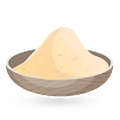Nan-e taftoon
(Taftan, Taftun, تافتون)
Nan-e taftoon is a type of Iranian flatbread, baked in clay ovens and served as an everyday accompaniment to a variety of dishes. This soft, slightly chewy bread is round and thin, and it often carries delicate impressions left by the baker’s fingers or a special bread stamp.
Its versatility has made it a staple in Persian households, where it is eaten fresh with stews, cheeses, herbs, or grilled meats. The history of nan-e taftoon goes back centuries, with references in Persian culinary records describing flatbreads cooked on hot surfaces or in domed ovens called tanoors.
As wheat cultivation spread and baking methods evolved, taftoon emerged as a common bread style alongside lavash, sangak, and barbari. Its name likely derives from the Persian word “taftan,” meaning “to heat” or “to bake,” reflecting the process of sticking the dough to the hot walls of the oven. Read more
Over time, regional variations developed in thickness, fermentation methods, and whether the bread was enriched with yogurt or milk. To prepare nan-e taftoon, bakers start with a dough made from wheat flour, water, a little salt, and yeast. Some recipes also include yogurt or milk to soften the crumb and create a more tender texture.
After kneading and resting the dough, it is divided into balls and rolled into thin rounds, typically 25–30 centimeters across. The rounds are pricked or stamped with small holes to help the bread bake evenly and prevent bubbles from forming.
In commercial bakeries or home kitchens with a tanoor, the dough is slapped against the hot oven wall, where it bakes quickly, developing a pale golden color with brown spots and a lightly smoky aroma. When serving, taftoon is often wrapped in cloth to keep it warm and pliable.
It is used to scoop up khoresh (stews), wrap kebabs, or accompany fresh herbs and cheese for breakfast and light meals. The bread can be folded or torn easily, and because of its mild flavor and soft bite, it pairs well with many foods without overpowering them.
Nan-e taftoon remains one of the most widely consumed breads in Iran, found in bakeries throughout cities and villages. While some families still bake it in home ovens, many rely on neighborhood bakers who produce fresh batches each day. Unlike thicker breads such as barbari, taftoon’s thinness allows it to be reheated quickly over an open flame or in a toaster, which is helpful in households where bread is purchased in large quantities and stored for several days.




